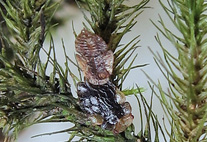Abstract
Three new species of the genus Ora Clark are described from Argentina: O. brevieminentia sp. n., O. megadepressa sp. n. and O. sigmoidea sp. n. All the species are characterized by a pair of frontoclypeal foveae, dorsal surface of mandible covered with setae, third labial palpomere arising from the inner margin of second palpomere, anterior pronotal angles distinctly projected anteriorly, a pair of glabrous areas on abdominal ventrites 2–5, ventrite 5 emarginate, with a pair of foveae in females, and tegmen with an apical digitiform lobe. Ora brevieminentia is similar externally to O. gamma Champion and O. platensis Brèthes, but it differs in having a more convex body, a smaller total length/elytral width ratio, coarser elytral punctation and a shorter lateral protuberance on the penis. Ora megadepressa is similar externally to O. depressa Fabricius, but differs in that the body is wider, the tegmen is laterally spiny with the lobe less narrowed basally, and the penis is straight with the base and the longer subapical process directed to the right-hand. Ora sigmoidea is similar in body color and shape to O. brevenotata Pic, and the aedeagus resembles that of O. texana Champion. However, the lobe of the tegmen is less protruding, the laminar dorsal piece of the penis is broadened, the apex is truncate, and the S-shaped ventral piece is distinctly curved.

